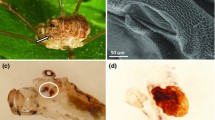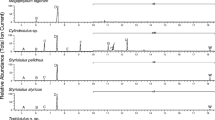Summary.
The presence of considerable quantities of hydroquinones including hydroquinone, 2-methylhydroquinone, 2,3- dimethoxyhydroquinone, 2-methoxy-3-methylhydroquinone, and 2,3-dimethoxy-5-methylhydroquinone renders the defensive secretion of Acladocricus setigerus (Silvestri, 1897) significantly different from that of other quinone-producing millipedes. In addition, two hitherto undescribed compounds, namely, 2,3-dimethoxy-5-methylhydroquinone and 2-methyl-3,4-methylenedioxyphenol, were characterized from the defensive secretion. However, it is uncertain if the latter compound is formed after the release of the secretion. The two major compounds, 2-methyl-1,4-benzoquinone and 2-methoxy-3-methyl-1,4-benzoquinone, constitute about 75% of the defensive fluid. Furthermore, hydrocarbons, which are typically present in the secretions of most other arthropods that use benzoquinones as repellents, are notably absent in the secretion of A. setigerus.
Similar content being viewed by others
Author information
Authors and Affiliations
Corresponding author
Rights and permissions
About this article
Cite this article
Wu, X., Buden, D.W. & Attygalle, A.B. Hydroquinones from defensive secretion of a giant Pacific millipede, Acladocricus setigerus (Diplopoda: Spirobolida). Chemoecology 17, 131–138 (2007). https://doi.org/10.1007/s00049-007-0372-1
Received:
Accepted:
Published:
Issue Date:
DOI: https://doi.org/10.1007/s00049-007-0372-1




